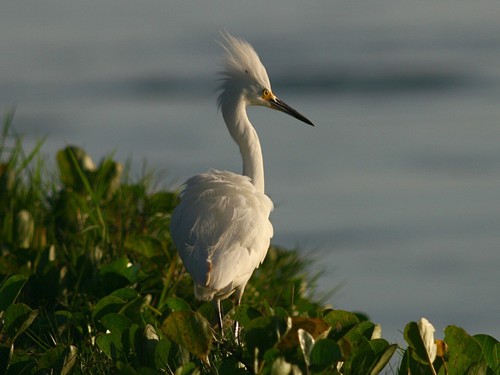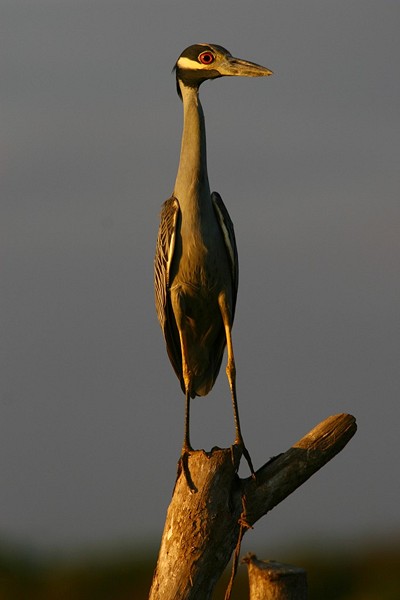

 LIKE THE MIGRATORY Blue-winged Teal Duck, eco-tour guide Michael Malone
spends his summers in Ontario, Canada and his winters in Puerto Escondido.
Mike started ecotourism around Puerto Escondido in 1985 when he befriended
a local taxi driver whose family lived at the nearby La Ventanilla lagoon.
LIKE THE MIGRATORY Blue-winged Teal Duck, eco-tour guide Michael Malone
spends his summers in Ontario, Canada and his winters in Puerto Escondido.
Mike started ecotourism around Puerto Escondido in 1985 when he befriended
a local taxi driver whose family lived at the nearby La Ventanilla lagoon.
They started taking tourists out to see the wildlife in a dug-out canoe made from the giant perota tree. The rest, as they say, is history. Recently, Mike and I went out together for a look at the various ecotourism activities happening in Barra de Navidad. Heading out southeast of town on Highway 200 towards Huatulco we crossed the bridge over the Colotepec river and turned right into Barra de Navidad. We first stopped in at Galo Sanchez's Producción Ecoturístico Colotepec.
Galo Sánchez is the person who started the reintroduction of turtles, iguanas and crocodiles into the wild. His place is on the left, after you pass the municipal buildings; there are hand-lettered signs in front. It's like a little zoo, with cages of various sized reptiles, many of which are released once they have reached the right size and age. Expect to pay a small donation if you stop to visit.
We work our way down to where the road ends and the Ballena Restaurant sits on the shore of the Colotepec River. The restaurant and related eco-tourism activities are run by a cooperative of local families. I asked how long the restaurant has been there and Concha, the lady who is working today, tells me that they have to rebuild the restaurant every season because the river is always moving. From there you can walk to a nearby lagoon with numerous crocodiles: for $50 pesos they'll take you out into the lagoon to observe them. They are also protecting sea-turtle nests on the nearby beach.
 That evening I come back and go out with a bunch of young people (children,
really) from the cooperative who wade across the Colotepec river to the
beach carrying almost 400 golfina turtles (Pacific Ridley) to release on the
beach at sunset. It truly is a hopeful moment as I watch a new generation
of Mexicans carefully releasing baby turtles from a species that was headed
for extinction just a few years ago.
That evening I come back and go out with a bunch of young people (children,
really) from the cooperative who wade across the Colotepec river to the
beach carrying almost 400 golfina turtles (Pacific Ridley) to release on the
beach at sunset. It truly is a hopeful moment as I watch a new generation
of Mexicans carefully releasing baby turtles from a species that was headed
for extinction just a few years ago.
We wind up the afternoon at La Ventanilla a few clicks further down the road towards Huatulco. There is a sign at the entrance and I was a little surprised since I had passed it by so many times without really ever noticing. (This is actually the other Ventanilla because most people think of La Ventanilla as the lagoon down by Mazunte.) The one we are at today is a small rain water fed lagoon called Los Naranjos. It also gets water from the Colotepec river when it dams up at its mouth and the river then works its way into La Ventanilla. There is a new palapa built by another cooperativa operated by the small pueblo of La Ventanilla across the highway. There are small boats that you can go out onto the lagoon for 50 pesos a person where you can see birds and crocodiles.
This is the lagoon where Mike Malone got his start with his taxista neighbor and it is with nostalgia that he chats with Julian, an older gentleman who is working today. They know all sorts of people in common including Ofelio, who used to own the place and reputedly had 22 children. Julian mentions that he has a silver ring he took off a dove he shot with a slingshot. Mike asks if there is any way he can get the information off the ring so that he can check it in the archives. Mike says he finally stopped doing the tours at this lagoon because in 1985 it dried up completely and moved on to Manialtepec Lagoon.
Mike explains that what he tries to do is to encourage the locals take ownership of the ecotourism projects. He tells me a story about how the local fisherman used to shake their heads and laugh at him when they would see him taking tourists out to see birds. He proudly tells me "Now every dock in Manialtepec has a sign that says "Bird & Nature Tours." He realizes the work is not so much about making money but about actually saving the environment.
 I also learn that Manialtepec is a deepwater lagoon up to 15 meters deep (45
feet) while Chacahua is a shallow lagoon three meters in depth. As a
result, Manialtepec has a much taller, lush mangrove ecosystem. There are
about 290 species of birds and depending on the type of birder there are
people looking to see the "endemics" or those birds specific to the area
(there are even people looking for just the Pacific Slope endemics) and then
there is me looking to see anything besides a seagull that is colorful and
doesn't fly away too fast.
I also learn that Manialtepec is a deepwater lagoon up to 15 meters deep (45
feet) while Chacahua is a shallow lagoon three meters in depth. As a
result, Manialtepec has a much taller, lush mangrove ecosystem. There are
about 290 species of birds and depending on the type of birder there are
people looking to see the "endemics" or those birds specific to the area
(there are even people looking for just the Pacific Slope endemics) and then
there is me looking to see anything besides a seagull that is colorful and
doesn't fly away too fast.
Gabriel de la Cruz Silos can be found dispensing cars and tourist advice at
Económica Rent-a-Car in Zicatela